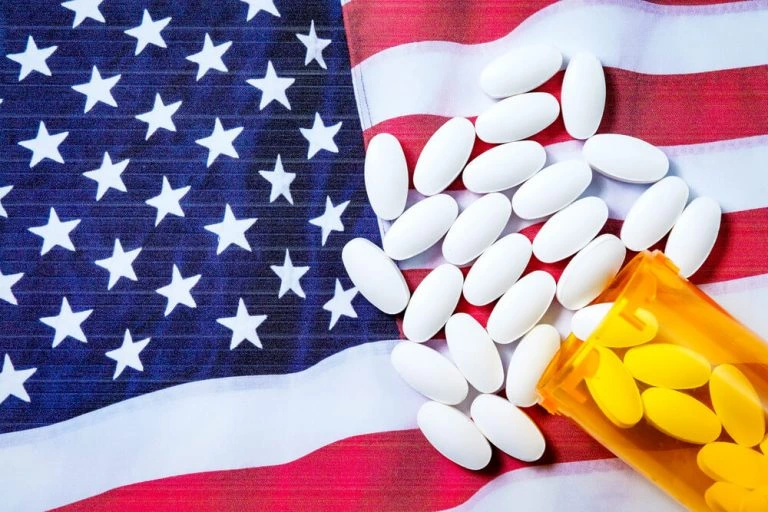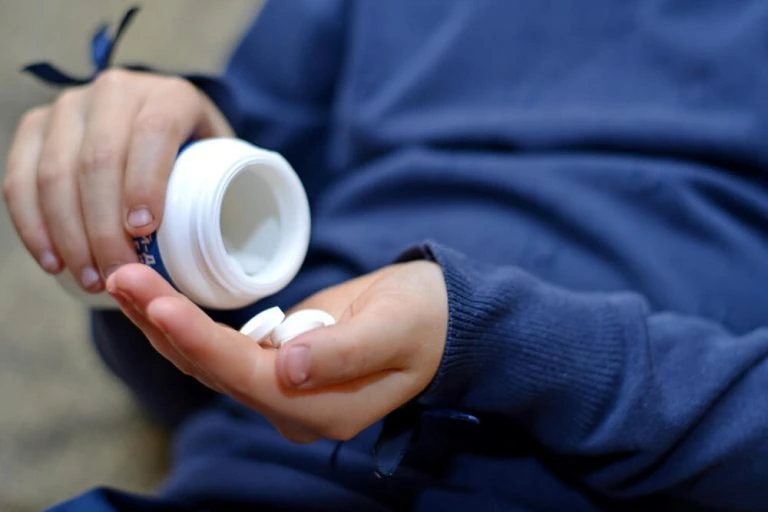Pethidine
Common Brand Names: Demerol, Meperitab
Pethidine, also known as meperidine, is an opioid analgesic indicated for the management of acute pain of moderate to severe intensity
The drug binds to and activates opioid receptors within the central nervous system. This process reduces the circulation of neurotransmitters responsible for the perception of pain, enabling pethidine to produce pain relief, sedation, and euphoria.
As a Schedule II substance under the federal drug scheduling system, pethidine carries an abuse potential that is comparable to morphine, and it is associated with a high risk for dependence.
How Is Pethidine Used Medically?
The US FDA has approved the use of pethidine or meperidine for the treatment of moderate to severe acute pain. In fact, even during the first half of the 20th century, pethidine was the drug of choice by many physicians among other opioids.Pethidine was also once a popular opioid analgesic for use during labor and delivery.However, due to its potential adverse effects and drug interactions, pethidine use in medical settings has seen a decline in recent years.
Because of its habit-forming capacity, the prolonged use of pethidine is not recommended. It is also contraindicated in patients who have known hypersensitivity or allergic reaction to the drug or to any of its components. Patients who are taking or have taken monoamine oxidase inhibitors within two weeks are also advised against pethidine therapy as concomitant use increases the risk of serotonin syndrome.
How Is Pethidine Abused?
According to the U.S. FDA, pethidine or meperidine is commonly abused by crushing, chewing, snorting, or dissolving and then injecting the product.Often, these practices are performed to speed up or increase the effectiveness of the drug.
However, uncontrolled administration of pethidine through the above-mentioned methods can result in significant risk of opioid overdose or death.
Pethidine Drug Interactions
Pethidine or meperidine can interact with a variety of drugs. These include:
- Monoamine oxidase inhibitors or MAOIs: Pethidine has been found to have serious interactions with monoamine oxidase inhibitors or MAOIs like furazolidone, isocarboxazid, moclobemide, phenelzine, and tranylcypromine. Some side effects include agitation, convulsions, delirium, and hyperthermia. There has also been a report about an 18-year-old patient who died after taking a combination of pethidine and phenelzine.
- Serotonin reuptake inhibitors or SSRIs: In addition, pethidine can also interact with selective serotonin reuptake inhibitors or SSRIs (a class of antidepressant drugs), resulting in serotonin hyperstimulation or serotonin syndrome.
- Other central nervous system (CNS) depressants: Drugs, including sedatives or hypnotics, general anesthetics, phenothiazines, other tranquilizers, and alcohol should not be used with pethidine because this can result in low blood pressure, respiratory depression, profound sedation, and even coma.
- Agonist/antagonist analgesics: Drugs like pentazocine, nalbuphine, butorphanol, and buprenorphine may reduce the analgesic effect of pethidine.
Pethidine Use Among Healthcare Workers
Pethidine or meperidine has an effective but short-time action, lasting only about 2 to 5 hours. As such, it’s necessary to receive repeated doses of it if an individual desires continuous pain relief, making it a potentially dangerous drug to those who have access to it.
While pethidine is not easily accessible on the streets, it has been described as “the doctors’ and nurses’ addiction,” in the United States, where healthcare workers who attempt to abuse it have easy access to it. Indeed, in one study in 2013, it was revealed that 65% of pethidine-addicted patients admitted to U.S. psychiatric hospital were healthcare workers.
Initially, pethidine was thought to be safer and has a lower addiction risk than morphine. This led to the widespread use of the drug as a pain reliever. However, further research proved that pethidine was not distinctly superior to morphine or other opioids. While this led to the decline in pethidine use in the United States, primary care doctors still prescribe the drug regularly.
Pethidine Side Effects
Some of the most common side effects seen in pethidine use include:
- Agitation
- Bradycardia (slower than normal heart rate)
- Confusion
- Constipation
- Delirium (especially in geriatric population)
- Diaphoresis (heavy perspiration)
- Dysphoria (state of unhappiness)
- Flushing
- Headache
- Involuntary movements
- Lightheadedness
- Nausea and vomiting
- Orthostatic hypotension (quick drop in blood pressure when standing)
- Palpitations
- Rashes, pruritus, and urticaria (hives)
- Tachycardia (abnormally fast heart rate)
- Tremors
- Urinary retention
- Visual disturbances
- Weakness
- Xerostomia (dry mouth)
On the other hand, serious adverse effects can include:
- Shock
- Seizures
- Syncope (loss of consciousness)
- Hallucinations (especially among the elderly)
- Severe hypotension
- Apnea (slowed or stopped breathing)
- Respiratory failure
- Cardiac arrest
Long-Term Effects of Pethidine
One of the most common long-term effects of pethidine or meperidine is opioid-induced androgen deficiency. Prolonged use can also trigger frequent seizures, due to the accumulation of normeperidine. Additionally, chronic use of pethidine can also cause dependence, which can then result in withdrawal symptoms if drug use is stopped suddenly.
Symptoms of Pethidine Overdose
Pethidine overdose can be fatal, and the risk of such events happening is high because this drug is a potent opioid analgesic that is a known habit-forming substance. The following signs and symptoms may indicate a possible opioid overdose due to pethidine:
- Cold, clammy extremities
- Drowsiness
- Lightheadedness
- Sleepiness
- Blurred vision
- Decrease in heart rate
- Decrease in blood pressure
- Extreme somnolence
- Irregular or difficulty breathing
- Muscle flaccidity
- Nausea and vomiting
- Convulsions
- Fainting
If you or a loved one is taking pethidine, talk to your doctor about having naloxone available at home or in the workplace. Naloxone is a drug that can block and reverse the harmful effects of opioids like pethidine, relieving the symptoms of an overdose. It’s also ideal to have naloxone ready if you live with small children. This way, they can be protected from an accidental overdose.
Signs of Pethidine Addiction
As an opioid analgesic, pethidine is only prescribed for short-term use. If someone has a history of substance abuse or has been prescribed repeatedly with pethidine, it’s ideal to keep close attention to their intake. This way, you can reduce the risk of pethidine abuse and misuse, which can develop into an opioid addiction.
According to the Diagnostic and Statistical Manual of Mental Disorders, Fifth Edition Edition (DSM-5), there are 11 signs of pethidine or meperidine addiction. These include:
- Taking pethidine in high doses or for a longer time than intended
- Being unable to cut down use of pethidine or stop its use, despite desiring to
- Spending a lot of time trying to acquire, use, or recover from pethidine use
- Cravings or feeling intense urges to use pethidine
- Using pethidine results in inability to manage commitments
- Continuing to use pethidine even though it causes relationship problems
- Giving up on important activities because of pethidine use
- Continuing to use pethidine, even though it puts you at serious risk
- Continuing use of pethidine despite it aggravating existing medical problems
- Increasing tolerance, characterized by the need to use higher and higher doses of pethidine in order to achieve its desired effects
- Developing withdrawal symptoms after abruptly stopping the use of pethidine
Signs of Pethidine Withdrawal
If you suddenly stop taking pethidine or meperidine after using it for a long period of time, you may experience the following withdrawal symptoms:
- Restlessness
- Watery eyes
- Stuffy nose
- Yawning
- Sweating
- Chills
- Muscle pain
- Irritability
- Nervousness
- Stomach pain or upset
- Vomiting
- Loss of appetite
- Diarrhea
- Fast breathing and fast heartbeat
- Back pain
Remember that it’s possible to develop pethidine dependence even if you’re taking the drug correctly or as prescribed by a physician. This is because your body becomes used to the presence of the drug over a period of time. However, it’s important to note that drug dependence isn’t the same as addiction. Addiction is a chronic dysfunction of the brain that manifests as compulsive substance use despite harmful consequences.
If you want to stop using pethidine, get in touch with your doctor or a drug rehabilitation facility. They will create an individual tapering schedule for you so that you can get the drug off your system in a way that is safe and comfortable for you.
Pethidine Detoxification
The best thing to do if you or anyone you know is experiencing withdrawal symptoms is to seek help and undergo pethidine detoxification at a medical detox facility. This is a program that will help you manage the worst withdrawal symptoms, and eventually eliminate the presence of pethidine in your body. Here are some of the things you can expect:
- Most pethidine detoxification programs start with a gradual lowering of your daily drug doses. You may also be given medications like naltrexone, buprenorphine, or methadone to either suppress cravings or provide further relief from withdrawal symptoms.
- Depending on the severity of your condition, additional nutritional supplements and IV fluids can also be given to you to help restore your health. These will only be given if deemed appropriate by the doctor in charge of your detox program.
- You will also be provided with round-the-clock monitoring to ensure that you feel well cared for throughout the detoxification process. This kind of support can contribute greatly toward the success of the program.
Rehabilitation and Treatment for Pethidine Addiction
The road toward complete pethidine addiction recovery can be a challenging one. Still, you will not be alone in this journey. Medical professionals, along with your family and friends, will be there to help ensure that you beat drug addiction and lead a sober life.
Typically, there are two options available for drug addiction treatment, and the right option will depend on your unique situation:
- Outpatient pethidine addiction treatment: If you have less dangerous symptoms, have shown a high likelihood of treatment compliance, and have a strong support system where you live, rehabilitation experts will most likely recommend outpatient addiction treatment. In this type of rehab, you will be allowed to live in your own home and maintain your usual daily activities such as going to work or attending school. You will only be required to attend the prescribed treatment programs at a designated facility.
- Inpatient pethidine addiction treatment: In contrast to outpatient addiction treatment, inpatient rehab means you’ll stay in the rehabilitation facility until the treatment program is complete. This is ideal for severe cases of addiction, where you or your loved one has a high risk of non-compliance to approved treatment protocols. Apart from providing medication-assisted treatment for opioid use disorder, inpatient rehab will also involve more intensive psychological interventions. These treatment modalities are aimed at helping you cope with your addiction while also allowing you correct behavioral patterns that increase your risk of relapse and further drug abuse. Round-the-clock medical supervision and care will also be provided to you to ensure the success of your treatment.
Find the Right Addiction Treatment Program for You
Overcoming drug addiction begins when you accept that you have a problem and that you need help. After this first step, it will be easier for you to seek treatment.
If you have insurance, you will be pleased to know that your policy probably already offers some form of coverage for both outpatient and inpatient addiction treatment. To be sure, call us at (800) 429-7690 to speak to one of our recovery support advisors, who can check your insurance coverage. If you don’t currently have insurance, we can help you find alternative ways to fund your treatment.
Begin your journey toward recovery today. Call now to find a treatment center and rehabilitation program that suits your unique needs.
A Brief History of Pethidine
Pethidine was first discovered by biochemists Otto Eisleb and Otto Schaumann in 1939 in Germany. Their studies found that pethidine had antispasmodic properties similar to atropine and was antagonistic to acetylcholine. In the same year, a clinical trial also concluded that pethidine possessed analgesic properties.
Following an initial report describing the use of epidural and intrathecal pethidine for the relief of postoperative and chronic pain, several papers were published that reported the efficacy of epidural pethidine for the management of acute pain. In the field of obstetrics in particular, epidural pethidine gained popularity for its use both as a labor and a caesarean analgesic.
In 1941, a study claimed that pethidine is a potent analgesic with an action similar to that of morphine. The researcher’s findings were confirmed by several other papers published thereafter. In 1942, however, a clinical trial found that high doses of pethidine have strong cortical effects that are potentially addictive. In addition, it was also discovered that normeperidine, a toxic metabolite of pethidine, has serotonergic properties that are highly associated with the development of seizures and serotonin syndrome.
The concerns surrounding the adverse effects of pethidine and its high risk for addiction led to its removal from the World Health Organization’s (WHO) List of Essential Medicines in 2003.








